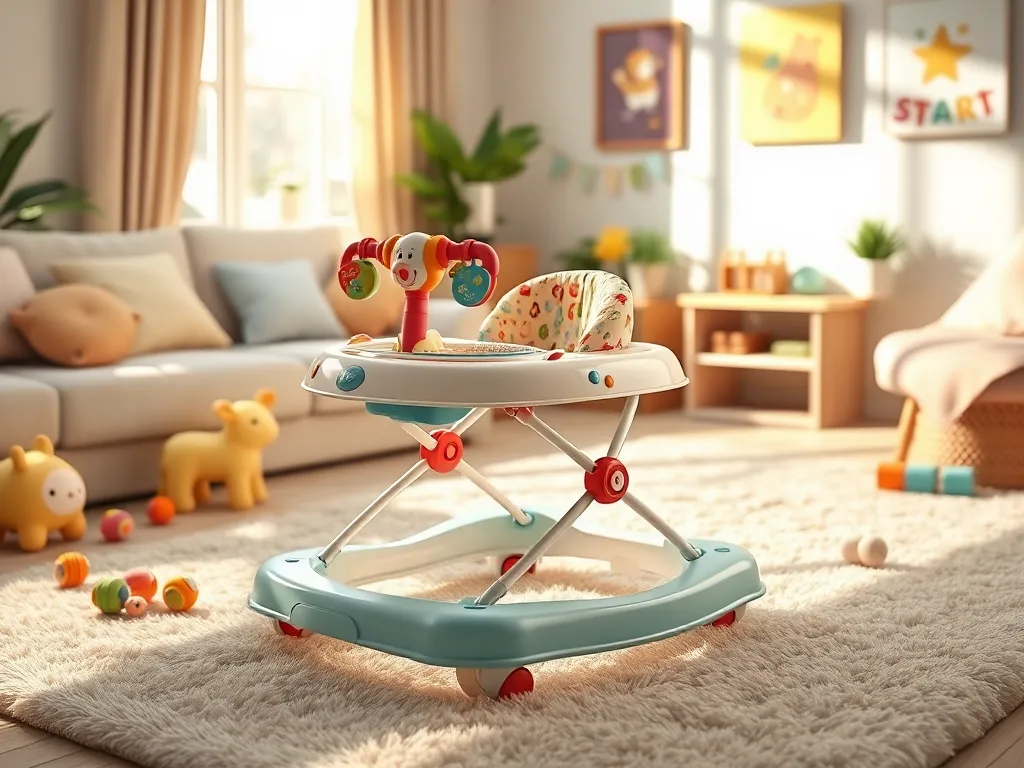Best Baby Walkers

All You Need to Know About Baby Walkers
Baby walkers are popular devices that assist babies in learning how to walk. They provide support and mobility, allowing infants to explore their surroundings and develop their motor skills. In this article, we will discuss the various types of baby walkers, their safety features, the benefits of using them, and safety tips for parents.
Safety is of utmost importance when it comes to baby walkers. Manufacturers design them with several safety features to ensure the well-being of your child. Some key safety features include a sturdy frame and wheels, a non-slip base, adjustable height, safety brakes, a padded seat, and toys and activities to keep the baby entertained. Additionally, many baby walkers have a foldable design, making them easy to store and transport.
There are several types of baby walkers available in the market, each with its own unique features. Traditional baby walkers are the classic design with a seat surrounded by a frame and wheels. Sit-to-stand walkers allow babies to transition from sitting to standing positions, encouraging them to take their first steps. Push walkers do not have a seat, but instead, provide support for babies to push themselves along. Activity and entertainment walkers offer various interactive features to engage babies while they are learning to walk. Convertible walkers can be transformed into different configurations to suit the baby's developmental needs. Lastly, glider walkers allow babies to glide smoothly across the floor with minimal effort.
Choosing the right baby walker involves considering several factors. Firstly, you need to take into account the age and development stage of your baby. Some walkers are suitable for younger babies, while others are better for more experienced walkers. Secondly, weight capacity is important to ensure that the walker can support your baby's weight without any safety concerns. Portability and storage options should also be considered, especially if you plan on traveling with the walker. Easy cleaning is another important factor to keep in mind as babies can be messy. Finally, budget-friendly options and positive customer reviews can help you make an informed decision.
Discover the top-rated Baby Walkers for your little one's first steps.
Using baby walkers comes with several benefits. They promote physical development by strengthening leg muscles and improving balance. Walkers also encourage independence and exploration as babies are able to move around on their own. Furthermore, they stimulate cognitive and sensory skills through interactive toys and activities. Baby walkers provide entertainment and fun for babies, allowing them to engage with their surroundings. Additionally, walkers enable parents to multitask as they can keep an eye on their baby while attending to other tasks.
One of the essential safety features of baby walkers is a sturdy frame and wheels. The frame should be strong enough to support the weight of the baby and provide stability. The wheels should be smooth and designed for easy maneuverability. This ensures that the walker moves smoothly without any sudden jerks or tipping over, reducing the risk of accidents.
A non-slip base is another important safety feature in baby walkers. It helps prevent the walker from slipping on smooth or slippery surfaces, ensuring that the baby remains stable while using the walker. The non-slip base adds an extra layer of security and minimizes the chances of accidents.
Adjustable height is a crucial safety feature in baby walkers. It allows you to customize the walker's height according to your baby's needs. As your baby grows taller, you can adjust the height to ensure that their feet touch the ground comfortably. This ensures proper posture and reduces the risk of strain or discomfort while walking.
Safety brakes are essential in baby walkers to prevent unexpected movements or rolling on uneven surfaces. The brakes ensure that the walker stays in place when it's not in motion, providing stability and safety for the baby. This feature is particularly important when the walker is used outdoors or on uneven terrain.
Types of Baby Walkers
Traditional baby walkers are the most common type available in the market. They feature a seat that is surrounded by a frame with wheels. The baby can sit in the seat and use their feet to move the walker forward or backward. These walkers usually have a tray or activity center attached to the front for added entertainment.
Sit-to-stand walkers are designed to aid in the baby's transition from sitting to standing and walking. They usually have a removable seat that can be used separately as a floor toy. As the baby grows, they can use the walker for support while learning to walk independently.
Push walkers do not have a seat for the baby to sit in. Instead, they provide support for the baby to push themselves along. Push walkers often have a handle or bar for the baby to hold onto while walking. These walkers are great for babies who are already comfortable standing and just need assistance with walking.
Activity and entertainment walkers are packed with features to keep the baby engaged and entertained. They usually have a variety of toys, buttons, lights, and sounds that encourage exploration and stimulate the baby's senses. These walkers are a great option for babies who enjoy interactive play.
Convertible walkers offer multiple configurations to adapt to the baby's developmental needs. They can be used as a traditional baby walker with a seat, or the seat can be removed to transform it into a push walker. These walkers provide flexibility and can be used for a longer period of time as the baby grows and develops.
Glider walkers are designed for smooth and effortless movement. They have large wheels that glide across the floor with minimal effort from the baby. Glider walkers often have a streamlined and sleek design, making them a popular choice for parents who prioritize style.
Choosing the Right Baby Walker
When choosing a baby walker, it is important to consider the age and development stage of your baby. Some walkers are designed for younger babies who are just starting to sit up, while others are better suited for older babies who are ready to take their first steps.
Weight capacity is another important factor to consider. Make sure to check the weight limit specified by the manufacturer to ensure that the walker can safely support your baby's weight. Using a walker with a weight limit that is exceeded can compromise its stability and safety.
Portability and storage options are worth considering, especially if you plan on traveling with the walker. Look for walkers that are foldable or easily disassembled for compact storage. Some walkers also come with a carrying handle or travel bag, making them convenient to transport.
Babies can be messy, so it is important to choose a walker that is easy to clean. Look for walkers with removable and machine washable seat pads. Additionally, walkers with smooth surfaces and minimal crevices are easier to wipe clean.
Budget-friendly options are available in the market, offering good value for money. However, it is important to ensure that the walker meets safety standards and has positive customer reviews. Reading reviews and conducting thorough research can help you find a budget-friendly walker that is also reliable and durable.
Positive customer reviews can provide valuable insights into the quality and safety of a baby walker. Reading reviews from other parents can help you gauge the overall satisfaction and performance of the walker. Look for walkers that have consistently positive reviews regarding safety, durability, and design.
Benefits of Using Baby Walkers
Using baby walkers offers several benefits for both babies and parents. Firstly, walkers promote physical development by strengthening leg muscles and improving balance. The act of pushing themselves forward in the walker helps babies build strength and coordination.
Walkers also encourage independence and exploration in babies. As they move around in the walker, they gain a sense of autonomy and can explore their surroundings at their own pace. This promotes a sense of confidence and self-reliance.
Baby walkers stimulate cognitive and sensory skills. The interactive toys and activities attached to the walkers engage the baby's senses, helping them develop hand-eye coordination, fine motor skills, and cognitive abilities.
Walkers provide entertainment and fun for babies. The toys, buttons, and lights on the walker keep them engaged and entertained while they are learning to walk. This makes the walking experience enjoyable and encourages babies to spend more time practicing.
Using a baby walker allows parents to multitask. While the baby is safely contained in the walker, parents can attend to other tasks, such as preparing meals or doing household chores. This saves time and allows parents to be more productive.
Safety Tips for Using Baby Walkers
Supervision is crucial when using baby walkers. Always keep a close eye on your baby while they are in the walker to ensure their safety. Never leave them unattended, especially in areas with potential hazards.
Choose a safe environment for your baby to use the walker. Clear the area of any sharp objects, furniture with sharp edges, or any other potential hazards that the baby may come into contact with while using the walker.
Avoid using baby walkers on stairs or uneven surfaces. The walker can easily tip over or cause the baby to lose balance, leading to injuries. Stick to smooth and flat surfaces for safe and stable movement.
Keep the baby walker away from pools, ponds, or any other water sources. Accidents can happen quickly, and the baby may accidentally fall into the water while using the walker. Water poses a significant risk for babies in walkers, so it is essential to keep them away from any potential water hazards.
Regularly check for recalls or safety updates on the baby walker you are using. Manufacturers may issue recalls or safety notices if there are any concerns with their products. Stay informed and be proactive about the safety of your baby's walker.
Use the baby walker for limited periods of time. While they can be beneficial for the baby's development, it is important to provide them with opportunities for free movement and unassisted exploration. Excessive use of walkers can delay natural walking development and may lead to dependency.
